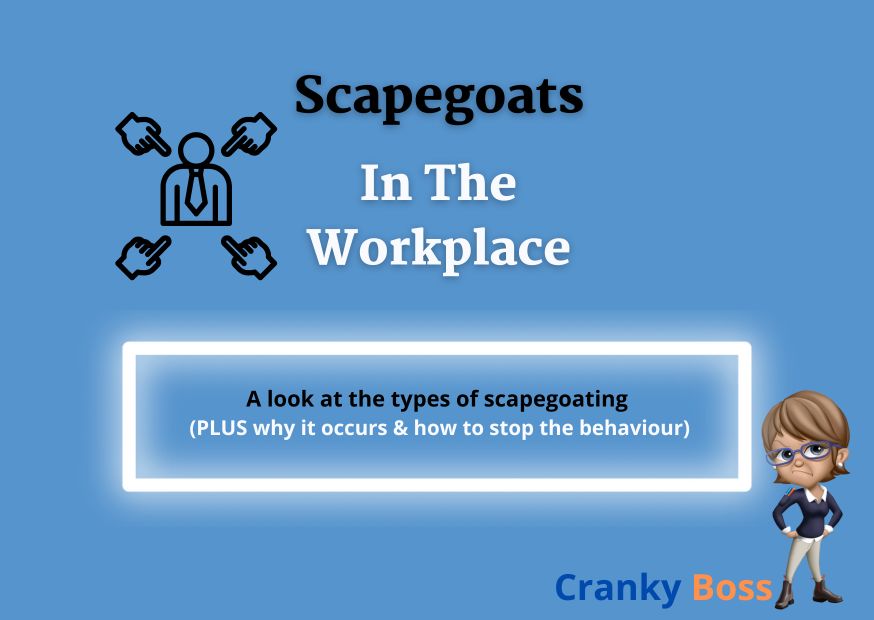In workplaces, scapegoating happens when someone is unfairly blamed for problems or mistakes, even if they didn’t cause them. This can create a negative environment and harm relationships among coworkers. Understanding scapegoating and how to respond to it is important for promoting fairness and teamwork in the workplace.
What is a scapegoat?
A scapegoat is a person or group who is unfairly blamed for problems, mistakes, or wrongdoing, often to deflect attention away from the real causes or responsible parties.

Where did the word scapegoat originate?
The word “scapegoat” has its origins in ancient religious practices. It comes from the Old Testament of the Bible, specifically from the Book of Leviticus in the Torah, which is the sacred text of Judaism. In Leviticus 16:8-10, during the rituals of the Day of Atonement (Yom Kippur), a goat was selected by the high priest to symbolically carry the sins of the people away into the wilderness. This goat, known as the “scapegoat,” would be sent into the desert to atone for the sins of the community.
Over time, the term “scapegoat” came to be used metaphorically to describe a person or group who is unfairly blamed or punished for the wrongdoings of others, much like the goat in the biblical ritual. Today, the term is widely used to describe individuals or groups who are unjustly held responsible for problems or mistakes, often as a way to avoid accountability or confront deeper issues.
What are the types of scapegoating?
- Individual scapegoating: This occurs when one person is unfairly blamed for problems or mistakes.
- Group scapegoating: In this situation, an entire group of people is blamed for an issue, often based on stereotypes or prejudices.
- Managerial scapegoating: Managers or supervisors may unfairly blame their subordinates for problems to avoid taking responsibility themselves.
- External scapegoating: Instead of addressing internal issues, blame is shifted to external factors such as clients, suppliers, or market conditions.
How do you respond to scapegoating?
- Stay calm: It’s important not to react impulsively when facing scapegoating. Take a moment to collect your thoughts before responding.
- Communicate: Discuss the situation calmly with the person or people involved. Explain your perspective and provide any evidence to support your innocence.
- Seek support: If you feel overwhelmed, reach out to a trusted colleague, manager, or HR representative for guidance and support.
- Document: Keep records of any instances of scapegoating, including dates, times, and details of what happened. This can be helpful if you need to address the issue formally.
What are some examples of scapegoating?
- Blaming someone for a project’s failure, even if they weren’t responsible for it.
- Holding a coworker accountable for a team’s poor performance, despite their efforts.
- Accusing someone of misconduct without proper evidence.
What type of person becomes a scapegoat?
Scapegoats in the workplace can be anyone, regardless of their position or personality.
What kinds of people are most likely to be targeted as scapegoats?
People who are perceived as different or outsiders, those who are less assertive or vocal, and individuals who are not part of the dominant group within the workplace may be more likely to be targeted as scapegoats. Additionally, those who challenge the status quo or question authority may also face scapegoating.
What do people achieve by scapegoating?
Scapegoating allows individuals or groups to deflect blame away from themselves, avoid accountability, and maintain a sense of power or control. It can also serve as a way to vent frustration or hostility towards others. Arrogant employees often use scapegoating tactics.
How do you stop scapegoats in the workplace?
- Promote a culture of accountability: Encourage open communication and transparency, where individuals take responsibility for their actions and decisions.
- Address conflicts promptly: Provide opportunities for conflict resolution and mediation to prevent issues from escalating.
- Educate employees: Raise awareness about scapegoating behaviors and their negative impact on individuals and the organization as a whole.
- Lead by example: Managers and leaders should model respectful and fair behavior, holding themselves and others accountable for their actions. Be a leader not a boss.
Signs you are the scapegoat at work
If you consistently find yourself blamed for problems or mistakes, marginalized or isolated by your coworkers, and subjected to unfair treatment or harassment, you may be the scapegoat in your workplace. It’s important to recognize these signs and take steps to address the situation. Rather than start taking days off or finding excuses to get out of work, deal with it by seeking support from trusted colleagues or HR, documenting instances of scapegoating, and advocating for yourself assertively but professionally.
Explanation of Why Scapegoating Occurs
Scapegoating often occurs for several reasons:
- Avoiding accountability: Individuals may seek a scapegoat to deflect blame away from themselves and avoid facing consequences for their own mistakes or shortcomings. By attributing problems to someone else, they can protect their reputation and maintain a sense of control.
- Maintaining power dynamics: Scapegoating can be a way for individuals or groups to assert their dominance and maintain power within a social or organizational hierarchy. By targeting someone perceived as weaker or less influential, they reinforce their own status and control over others.
- Managing anxiety and uncertainty: During times of stress or uncertainty, people may seek a scapegoat as a way to alleviate their anxiety and regain a sense of security. Blaming someone else for problems or failures can provide a temporary sense of relief and control over chaotic situations.
- Group cohesion: Scapegoating can also serve to strengthen group cohesion and solidarity. By uniting against a common enemy, individuals within a group may feel a sense of belonging and camaraderie, reinforcing their bonds with one another.
What are the signs of scapegoats at work?
Scapegoating can present itself in various ways in the workplace and other social settings. Some common manifestations of scapegoating include:
Undermined: Their contributions and achievements may be disregarded or minimized. Undermining behaviour can be subtle like witholding information or ignoring input. Additionaly, their coworker may treat them like subordinates.
Blame-shifting: Scapegoating often involves assigning blame to a specific individual or group for problems or mistakes, even if they are not responsible. This blame-shifting can be overt, with accusations made directly, or subtle, with the scapegoat being subtly undermined or marginalized.
Exclusion: Scapegoats may find themselves excluded, ignored or isolated from their peers, either socially or professionally. They may be left out of important meetings, projects, or discussions, or deliberately excluded from social gatherings and interactions.
Negative labeling: Scapegoats may be subjected to negative labels or stereotypes that reinforce their role as the designated target. They may be portrayed as incompetent, lazy, unreliable, or untrustworthy, regardless of their actual abilities or performance.
Unfair treatment: Scapegoats may experience unfair treatment or discrimination in the workplace, including verbal abuse, harassment, or sabotage of their work. Co-workers may spread lies about them to their boss. They may also be denied opportunities for advancement or recognition, despite their qualifications and contributions.
Hostility and aggression: Scapegoating can create a hostile and aggressive environment, with the scapegoat becoming the target of verbal attacks, bullying, or intimidation from their peers or superiors. In some instances gaslighting can also be present.
High turnover: In workplaces where scapegoating is prevalent, there may be a high turnover rate as individuals who are targeted or witness scapegoating choose to leave the organization rather than endure the toxic environment.
Summing Up
Overall, scapegoating is often driven by a combination of psychological, social, and organizational factors, including the desire to avoid accountability, maintain power dynamics, manage anxiety, and foster group cohesion. However, it’s important to recognize that scapegoating is harmful and unfair, and efforts should be made to address its root causes and promote a culture of accountability, fairness, and respect in the workplace and beyond. Furthermore, Creating fair and equal workplaces through diversity and inclusion is paramount to running a successful workplace.

